|
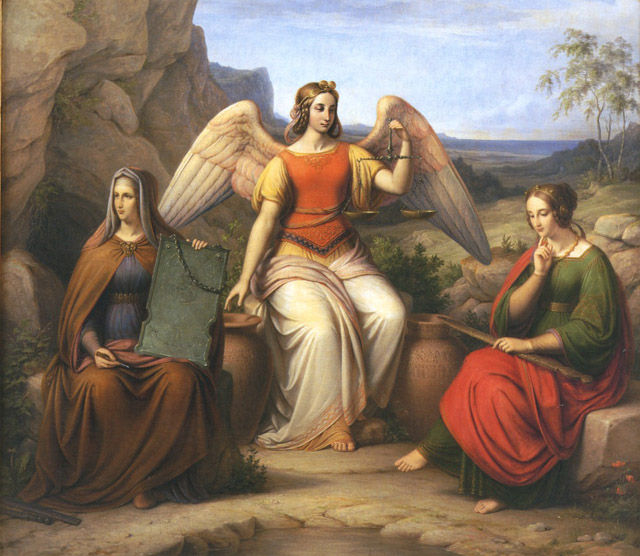
The
Nornir sat beneath Yggdrasil, the Tree of Life, weaving the threads of
destiny, even those of the gods.
Life
is a set of
interwoven threads, like the warp and weft of a loom, a glorious tartan
that
not only surrounds us but makes up the very fabric of our existence and
identifies the clan to which we belong.
Well,
that's an old
and once-popular metaphor. But in astrology, it may be more of a
compelling
truth than you might expect. Outside of all the possible meanings of a
single
natal chart, there is the simple grid of 360 degrees of the Zodiac, the
latticed playing field on which all planetary positions are recorded,
devoid of
interpretation.
That
tells an
unquestionable story by itself about who runs into whom, which threads
cross
and recross enough to make a pattern, a weave, a family. Populating the
360
degrees of the circle are the traditional ten planets, the lunar nodes,
the
Angles (Asc-Dsc, MC-IC), and the Vertex (sometimes called an angle in
itself).
Some astrologers use even more, but these are enough to guarantee some
overlap
of the planetary threads of any two charts, between people of any age.
When
you look at your
own natal chart, alone, the bare positions of these traditional points,
outside
of their traditional astrological interpretations, mean nothing.
They're just
there. But overlay your parents, your siblings, your children, your
co-workers,
the people in your recent phone or email correspondence, your
progressions, and
the current positions in the sky and you'll start to see individual
degree
areas bunching up like crazy, in a provocative fashion. It's not
random, there
are regular clusters, and over a lifetime the clusters stay in the same
places.
Whatever the specific degrees - usually (but not always) obvious
degrees in
your own chart - they repeat themselves again and again. It's like
you're
locked into a weave that was there when you were born and keeps coming
back to
you, a celestial family with DNA that's totally extraterrestrial.
Journalists
these days bemoan the lack of family and social connections - the fact
is,
there are more there than you may want, you just haven't noticed it.
And
further, like biological family but more permanent, you're stuck with
them.
Astrologers
see it all the time, but rarely note it except in passing. I remember
when I
had an ad in the New York City yellow pages, and over ten years only
people
with lots of similar degrees called, no random pattern there. They
could have
called anybody else in the listings, but they didn't. They called me.
All the
others simply didn't call. They called the other astrologers in the
yellow
pages who had their degrees, instead. There are some degree areas (not
populated in my own chart) which I have simply never met. No reason to
cross
paths, apparently. And other astrologers regularly report the same. Is
it some
cosmic principle of attraction? Paul Kammerer
thought so, and it's why he believed "synchronicity" was no accident.
It's a great tool for
rectification (finding someone's true birthtime, when they don't know
it) - all
you have to do is collect charts of all their friends and family and
the
preponderance of the degrees that turn up are their natal angles).
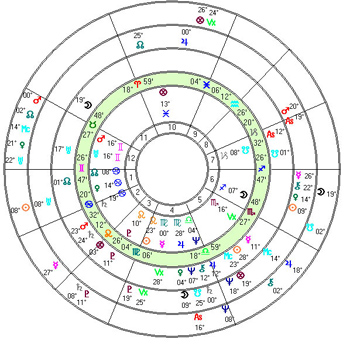 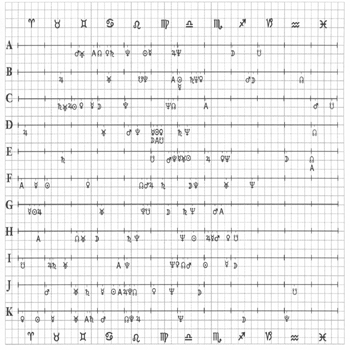
Overlapping
degrees can be spotted by
traditional circular or linear overlays. A computer version
could include more.
It
forms the essence
of traditional astrological compatability, synastry, and comparison.
Whatever
the immediate passion between two people, if they have lots of shared
degrees
between their charts, they will tend to stay together, at least as
friends, or
even enemies. Circumstances just tend to shepherd them both into the
same
situations. If they have few degree contacts, even the greatest passion
will
have to fight circumstances just to stay in the same neighborhood.
Composite
charts are another story, as they start slowly, but gain momentum over
time,
but they, too, usually reflect the same degrees. Of course, there are
many
people you have never met with lots in common with you, and you don't
know
them, yet. But once you actually meet, just watch how difficult it
becomes to
escape them. That's perhaps why first meetings and introductions are so
important - they are gateways to floods of experience that you may
quickly lose
control over.
In
non-astrological
terms, this type of event is considered ordinary. It's just the way
life works.
For all the gossip, Hollywood stars marry other Hollywood stars -
mainly
because that's the world they live in and they never get to meet
anybody else,
even if they occasionally go out and meet ordinary people elsewhere.
But the
same principle appears to extend to the rest of life, in ways where we
don't
get to go choose to meet other "ordinary" people elsewhere, because
we're not even aware of the option. And if we do accidentally meet, we
don't
notice them, and they don't notice us, like ships passing in the night.
The
mathematics and the probabilities of this could be debated forever, but
the
ultimate test is specific and often anecdotal. Don't you notice it
yourself?
Have you known anyone for very long that doesn't have a lot of degree
areas in
common with you? At a glance, it should become obvious. After that, you
begin
to focus on the individual common degrees and see which parts of that
warp and
weft you share with another influence each of you, one to the other. Is
it
Saturn (a teacher) or Jupiter (an inspirer), perhaps Mar or Venus
(physical,
sexual), or raw energy and timing with Sun and Moon and the Angles? But
if
there is no commonality, it just doesn't generally happen long enough
to answer
the question - the term "star-crossed" meant just that when it was
coined. Some of us are swimming in the same river together, others
simply
aren't.
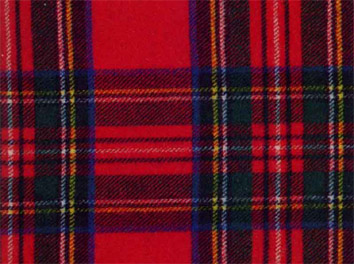 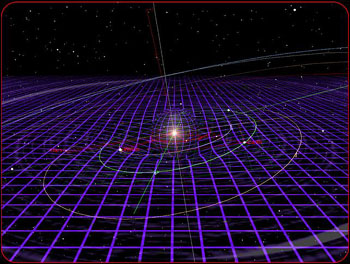
As individual
planetary threads intersect, the final fabric of your cosmic clan
tartan takes shape.
How do
you explain
this? Probably that mutual attraction thing. Astronomically, the
planets do it,
by gravitation, and it's described by LaGrange points. A simple
extrapolation
of these five points defines all the common astrological aspects and
their
meanings. It's about repetition and locking yourself into the familiar
by
simply doing it over and over again, just like the tides that go in and
out.
Only
it's more
complicated, like the tides themselves. Some creatures live their lives
and
meet their mates only at high tide, others only at low tide, others
only at
certain points in between. Most are never even aware of those who do
otherwise,
on a different tide. Just a simple look at how we individually overlap
by
degree areas shows this same principle in action. Cosmically,
astrologically,
gravitationally, however you want to put it, it's about the greater
family you
are thrown into simply by your beginning, regardless of biological
ties. You
may not notice it right away, but as you get older you begin to just
know them
at first glance, although astrological awareness and comparisons really
help to
flush out the details - oh, here comes another one, and another one,
some
better, some not so nice. You can't avoid them, they're family.
The
question and
decision at any one moment is, "Should I invite them in?"
-- John Townley
|

